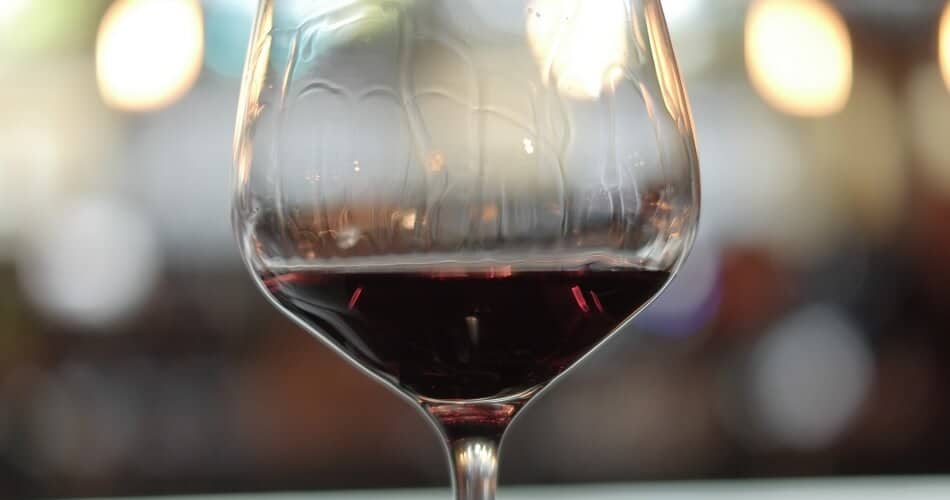For sure, you have seen it often: People swivel their glasses and swirl the wine inside before drinking. This ritual might look bizarre to someone who has only limited knowledge about wine. But actually, swirling wine is an important action that has an enormous impact on the wine experience. So what happens when you swirl wine in your glass?
Swirling wine allows it to breathe. That means the wine gets in contact with air, or more precisely, oxygen. The oxygen helps the wine release its aromas, so the smelling and tasting experience will be much more pleasant. So if you swirl wine in the glass, you make sure it can showcase its full quality.
But there are more reasons to swirl the wine in the glass before drinking it. All of them are connected to your wine-drinking experience. Read on to learn about them and how to swirl wine like a pro.
WHAT HAPPENS WHEN YOU SWIRL WINE?
When you swirl wine and get it in contact with oxygen, multiple chemical reactions take place in the glass. And they result in a more enjoyable experience for you. Besides, the movement of the wine itself can give you information about its taste before it hits your tongue.
Swirling Allows Wine to Open Up
By swirling wine in the glass, you increase its surface. A bigger share of it gets in contact with oxygen. When this happens, the oxygen attaches itself to the tannins in the wine and causes them to break down. This gives the wine a softer nature. Besides, it allows the more subtle aromas to break free so that the wine can release its full complexity.
Killing Unpleasant Aromas
Another process that takes place when you swirl wine is evaporation. The movement of the wine makes some of its volatile compounds disperse. Luckily, evaporation affects primarily undesired compounds. One example is sulfite which smells like rotten eggs. But evaporation also affects oaky and herbaceous aromas that are rather boring. Swirling makes these unpleasant aromas disappear, so there is more room for exciting and delicious sensations.
Swirling Wine Helps You Enjoy Your Experience
Finally, swirling wine activates and aromatizes esters. Esters are aromatic and fruity compounds that are created during the fermentation and aging process of the wine. The swirling causes these esters to concentrate in the glass, right above the surface of the wine.
This concentration makes it easier for you to smell all the nuances and enjoy a wine’s bouquet to the maximum. By the way, with the right glassware, you can support this process to improve your wine experience further.
Wine Legs and Their Meanings
Swirling does not only improve the smell and taste of wine. It also allows you a better visual investigation. When the wine moves in the glass, you will get a better impression of its color. And the color gives you hints about the wine’s body.
But even more important, you can check out the legs. When you slowly swirl the wine, it will form streaks on the side of the glass. These streaks are called “legs” or “tears”. They give you essential information about the wine’s characteristics:
- The higher the alcohol level of the wine is, the more legs you will see and the longer and thicker they will be.
- The sweeter the wine is, the higher its viscosity, and the slower will the legs flow back down the side of the glass.
Be aware that the surrounding temperature and humidity affect the forming of legs. So if you swirl wine on a summer day, its legs will behave differently than in the middle of a cold night.

Buying Yourself Time
Expectation and anticipation are important aspects of the wine experience. Thinking about how a wine might smell and taste is fun, but it also needs a little time. By swirling wine and observing its color and its legs, you can buy yourself more time to set your expectations.
HOW TO SWIRL WINE PROPERLY
Swirling wine properly is no rocket science. As there is no perfect swirling technique, there isn’t much room for error either. Here is how you do it:
- Put your glass on a table or another solid surface and fill it with wine. Remember that wine is served in small portions. One reason for small servings is to have enough space in the glass left for swirling.
- Hold your nose over it and check its smell. Analyze the aromas you can sense.
- Grab the glass by the stem with your thumb and index finger. If you grab it close to the base, you will prevent the warmth of your hand from heating the wine.
- Move the glass gently in small circles while its base still touches the table. If the wine swirls in the glass without sloshing out of it, you are doing it right.
- Now, smell the wine again and compare its aromas to your sensations before swirling it.
Of course, you can also swirl the wine without a table. Make sure you do not lose your grip on the glass by using more fingers.
Should You Swirl Wine Clockwise or Counterclockwise?
The swirling direction does not matter for the taste or smell of wine. You might have heard that only rotating the glass clockwise allows the wine to release its fruity aromas. Another common rumor is that moving the glass counterclockwise causes bad luck. All of these claims are nonsense. Whether you swirl wine clockwise or counterclockwise does not change your experience at all. Feel free to choose the direction that is more comfortable for you.
How Long Should You Swirl Wine?
There is no carved-in-stone rule about the swirling time. Doing it for 5 to 10 seconds usually is sufficient. You will not improve your experience significantly by doing it longer. Wines that need more aeration should be decanted before serving.
How Often Should You Swirl Wine?
Swirling wine once is perfectly fine. Just like taking longer turns, a second or third round of swirling won’t improve its smell or taste noticeably.
Can You Swirl Wine Too Much or for Too Long?
In theory, it is possible to swirl wine for too long. If you do it for hours, the oxygen will fully oxidize the wine. Like leaving a bottle open overnight, this will ruin the wine and make it flat or even bitter. However, no reasonable person would do that. And swirling wine ten seconds longer or shorter will not do any damage to your tasting experience.
WHICH WINES DO YOU SWIRL?
You can swirl wines of all types. The more complex the wine is, the more perceivable will the effect on aromas be. Thus, especially bold, red wines with high levels of tannins and alcohol benefit from swirling.
Do You Swirl White Wine?
You definitely can swirl white wine. Just like red wine, it will benefit from exposure to oxygen. But whites usually are low-tannin wines that are less complex than reds. Thus, the difference in smell and taste before and after swirling will be less significant.
Do You Swirl Rosé?
You can swirl rosé wines, but the effects will be similar to those for white wine: As rosé is less complex than red wine, the detectable effect might be marginal. However, you definitely can improve your experience.
Do You Swirl Dessert Wine?
Dessert wines can be as complex as rich red wines. In these cases, swirling will enhance your tasting and smelling experience. Besides, they are usually sweet, and they often contain a lot of alcohol. So the legs that form during swirling are fascinating to watch.
Do You Swirl Ice Wine?
Ice wines do benefit from swirling. They are very complex wines, and if you try them untouched, you will most likely not be able to enjoy their complexity to the fullest. Thus, you should swirl ice wine to get it in touch with oxygen and make it open up.
If you drink ice wine from special ice wine glasses, you must be careful, though. These glasses are smaller than regular wine glasses, so there is a bigger risk of sloshing wine.
Do You Swirl Sparkling Wine and Champagne?
Sparkling wine should not be swirled, and here is why: An essential aspect of enjoying sparkling wine is the fizzing sensation of its bubbles. These bubbles are carbon dioxide (CO2). When you open the bottle and fill your glass, this CO2 slowly escapes. By swirling your glass, you speed up this process. The CO2 disappears faster and leaves your sparkling wine flat and dull.
Besides, the CO2 transports the aromas to the surface while it slowly escapes. So swirling is not necessary to release a sparkling wine’s full taste. For these reasons, you should never swirl a glass of sparkling wine.
DO YOU SWIRL WINE IN A DECANTER?
Swirling wine in a decanter before serving is an option as well, but not for every wine. Besides exposing the wine to oxygen, decanting has another purpose: removing the sediment that might have formed. That is important for older wines in particular. Swirling the decanter would harm this purpose and result in more sediment ending up in your glass. Thus, you should only swirl wine in a decanter if you are sure that it does not have any sediment in it.
FINAL WORDS
Swirling is a key part of enjoying a good wine. What might look weird at first glance starts a process that will help the wine release its aromas and rise to its full potential. With this article, you have gained all the theoretical knowledge about swirling wine. You know what happens to your wine when you do it, and you know how to do it.
Now, it is time to get into practice and test the effect of swirling yourself. Smell and taste the wine before and after swirling to experience the differences. I am sure that you will never drink your wine without swirling again afterward.
Recent Posts
Switzerland is famous not only for its beautiful landscapes and its picturesque towns but also for some food items. Especially Swiss cheese and chocolate are world-famous. But do you actually know a...
Winemaking is a sophisticated process that includes multiple steps and can take several years. Depending on the desired wine and the vintner's preferred techniques, these steps can differ. However,...

